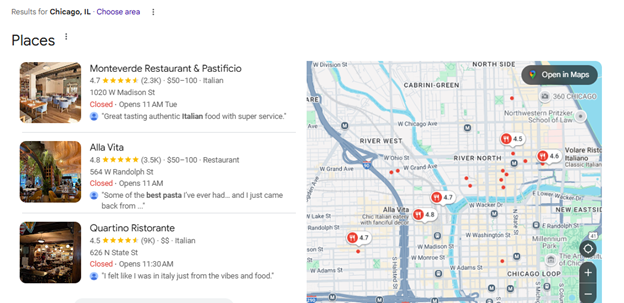Most professionals come under the radar of this one local SEO myth — that it is only meant for brick-and-mortar businesses. While it’s true that businesses having physical storefronts are more likely to capitalize on local listings, it’s not entirely fair to say that local e-commerce businesses can’t. This should come as no surprise, as many online stores also rely on traffic originating from a specific geographic location. Thus, implementing local SEO practices may help expand their reach to a broader audience by targeting individuals in a specific local area.
What is the Importance of Local SEO?
Local SEO can be a major traffic asset for all sizes and shapes of businesses. Whether it’s a storefront business that relies on foot traffic or an online products and services site, ranking on SEO features like Snack Packs, Google Map listings, and location directories provides a significant edge on the SERPs. This is where almost all the incoming traffic results in clicks and/or user actions.
According to the latest stats, about 46% of all searches on Google are looking for local information. If you search on Google for a local keyword, the results page is most likely to feature local map listings and directory listings in addition to organic search. Let’s take the example of the search term “best italian restaurants in chicago.”
This search returns local listings from Google Maps, also called Snack Packs. This Google feature alone is known to generate about 33% clicks on the SERP.
On the other hand, organic search generates a total of 40% clicks. Optimizing your website for local SEO will help you rank on both of these listings, which is why it is essential for all businesses to apply local marketing strategies to their business models — whether physical or online.
Is Local SEO only for Brick-and-Mortar Businesses?
As discussed above, local SEO for non-physical businesses is just as important as for small-scale, physical stores. This is because both businesses can benefit from regional traffic — both online and offline. Let’s understand this further with the help of an example.
Suppose you have a coffee shop in Visalia, California, and you are looking to attract more customers. Applying geo-targeting strategies will help get your business in front of all locals and visitors in Visalia.
While the above is an ideal business model for local SEO, less conventional businesses can also benefit from it. For example, an online boutique shop that delivers custom dresses across town is a great candidate for geo-targeted marketing. Similarly, a pet supply store that offers medical care and delivers supplies right to your door can also take advantage of local Map listings.
The trick is to target people in a specific radius around your business. This lets you focus your services where they matter most — within the local community where your most ideal customers exist. With a clear and effective geo-targeting strategy in sight, getting more organic traffic and clicks is a piece of cake.
How Local SEO Helps Businesses?
Local SEO can help place your business in front of the right audience. It keeps your searches segmented based on your service’s physical location. This marketing strategy is a goldmine when used as a long-term KPI. The fact that it doesn’t involve online advertisement is another major reason to consider shifting the focus to this regionally focused section of SEO.
As an online business owner, believing in the local SEO myth that it’s only valuable for offline stores means you’re cutting out an entire traffic stream to your website. Here is how local targeting helps businesses existing online:
Improves Visibility: Unlocks various listing opportunities for your business, amplifying reach and bringing your business to a higher pedestal within local searches.
More Clicks on Google Maps: About 45% of people use Google Maps to find businesses near them. Because local SEO puts your business on Maps, you are much more likely to get featured in one of these results, prompting clicks and revenue.
Boosts Mobile Search Performance: A lot of customers search on the go with their mobile devices, which ultimately contributes to mobile search performance for your business.
Lowers Competition: Rather than targeting a large audience base, local SEO lets you focus on a specific subsection of the audience with lower competition in the search sphere.
Ready To Optimize? Here is An All-Around Local SEO Checklist
It’s never too late to start, so if you haven’t applied local SEO to your e-commerce store, it’s time to get rolling. Don’t stay under the misconception that local SEO only belongs to brick-and-mortar businesses.
Start working to build a strong local customer base in your target areas with these hit local SEO tactics:
- Optimize your website for mobile, as they are more likely to contact you via your local listings.
- Claim your Google My Business Listing. To proceed, you will need a name, address, and contact number. As a pro move, add your website here as well to allow an indirect stream of traffic.
- Use local keywords to target your region, such as ‘dog care in Canberra’, ‘electronics repair in downtown eastside’, or ‘furniture delivery service in Brisbane.’ You may also optimize for hyperlocal keywords that target street names, districts, and landmarks to further narrow down the competition.
- Create Location Pages on your website with all the information about your services or products available in a specific area.
- Produce content that caters to the audience existing in a selected locality.
- Get featured in local directories, including those on Yelp, TripAdvisor, and BingPlaces.
- Find guest posting opportunities within the local blogger community.

